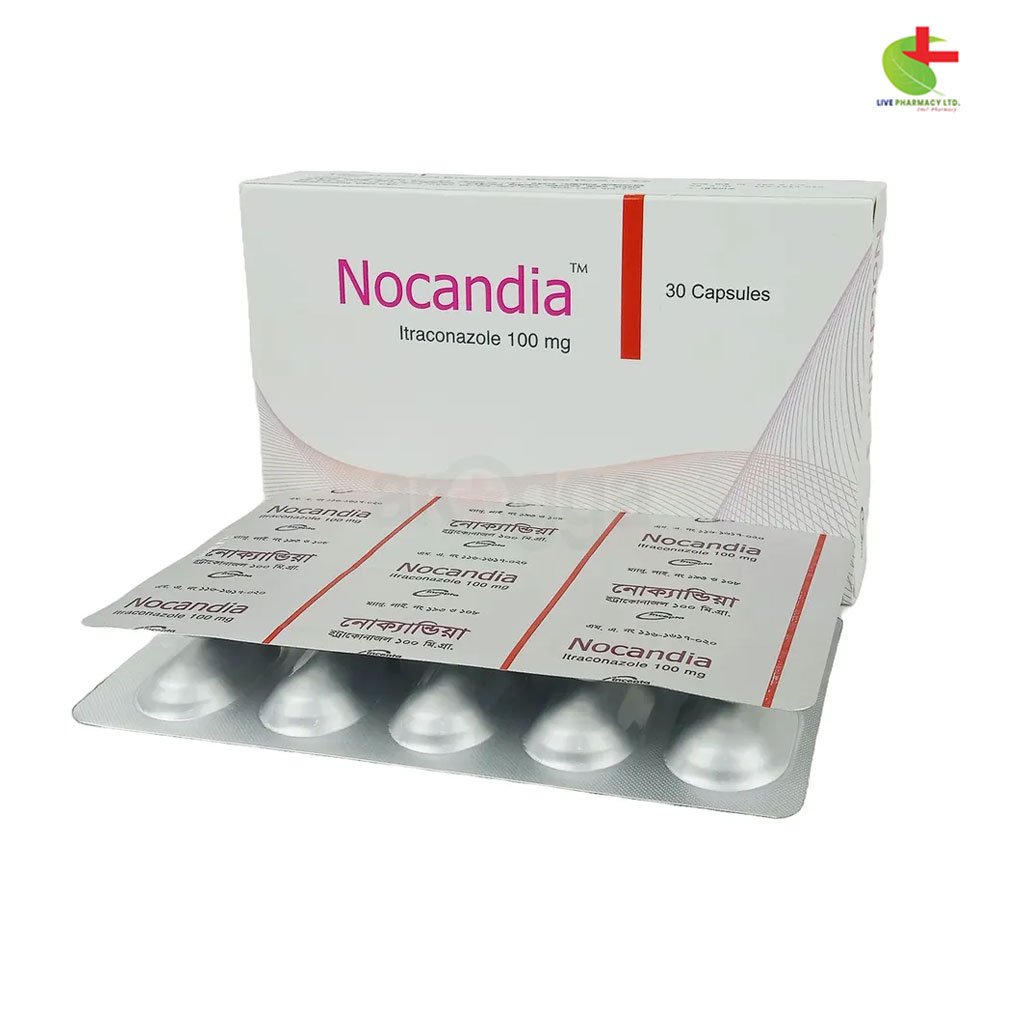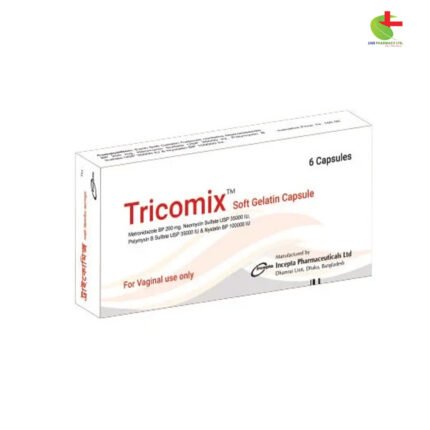Nocandia 100
170.00৳ Strip(10)
- Nocandia is used to treat a variety of fungal infections, including oropharyngeal and vulvovaginal candidiasis, tinea infections, and systemic conditions like aspergillosis and cryptococcosis.
- It works by inhibiting ergosterol synthesis, essential for fungal cell membranes, using SUBA technology to enhance absorption.
- Available in multiple dosages, it can be used in both systemic and non-systemic fungal infections.
- Not recommended during pregnancy or breastfeeding; caution is advised for those with hepatic conditions.
 Brand
Brand
|
Incepta Pharmaceuticals Ltd |
|---|---|
 Generics
Generics
|
Itraconazole |
 Type
Type
|
Capsule |
Indications
Nocandia is indicated for treating a range of fungal infections, including oropharyngeal and vulvovaginal candidiasis, pityriasis versicolor, and various forms of tinea (such as tinea pedis, cruris, corporis, and manuum). It is also effective in managing onychomycosis, histoplasmosis, systemic candidiasis, aspergillosis, and cryptococcosis (including cryptococcal meningitis). Nocandia is additionally used as a maintenance therapy for AIDS patients to prevent the recurrence of fungal infections and as a prophylactic treatment for fungal infections in patients with prolonged neutropenia. For best results, use this medication under the guidance of a licensed healthcare professional.
Pharmacology
Itraconazole, the active ingredient in Nocandia, inhibits Cytochrome P-450 dependent enzymes, thereby disrupting the biosynthesis of ergosterol, a crucial component of fungal cell membranes. This interruption leads to changes in membrane permeability, affecting enzyme activities and cell wall structure. SUBA (Super Bio-available) technology, incorporated in Itraconazole, enhances bioavailability by increasing the solubility of poorly absorbed drugs. This advanced formulation makes Nocandia effective as an orally active triazole antifungal with a broad spectrum and favorable pharmacokinetic properties.
Dosage & Administration
100 mg & 200 mg
For non-systemic fungal infections:
- Vulvovaginal candidiasis: 200 mg twice daily for 1 day
- Pityriasis versicolor: 200 mg once daily for 7 days
- Tinea corporis/tinea cruris: 100 mg daily for 15 days or 200 mg daily for 7 days
- Tinea pedis/tinea manuum: 100 mg daily for 30 days
- Oropharyngeal candidiasis: 100 mg daily for 15 days; increase to 200 mg daily in AIDS or neutropenic patients for 15 days.
- Onychomycosis: 200 mg daily for 3 months or pulse dose of 200 mg twice daily for 7 days with intervals of 21 days.
For systemic fungal infections:
- Aspergillosis: 200 mg daily for 2-5 months (increase to 200 mg twice daily if invasive)
- Systemic candidiasis: 100-200 mg daily for 3 weeks to 7 months (increase if invasive)
- Non-meningeal Cryptococcosis: 200 mg daily for 10 weeks
- Cryptococcal meningitis: 200 mg twice daily for 2-6 months
- Histoplasmosis: 200 mg once or twice daily for 8 months
- AIDS maintenance therapy: 200 mg daily until immune recovery
- Neutropenia prophylaxis: 200 mg daily until immune recovery
65 mg & 130 mg
For non-systemic fungal infections:
- Vulvovaginal candidiasis: 130 mg twice daily for 1 day
- Pityriasis versicolor: 65 mg twice daily for 7 days
- Tinea corporis/cruris: 65 mg daily for 15 days or 65 mg twice daily for 7 days
- Oropharyngeal candidiasis: 65 mg daily for 15 days (increase if AIDS/neutropenia)
For systemic fungal infections:
- Aspergillosis: 65 mg twice daily for 2-5 months; increase if invasive
- Systemic candidiasis: 65-130 mg daily for 3 weeks-7 months (increase if invasive)
- Non-meningeal Cryptococcosis: 65 mg twice daily for 10 weeks
- Cryptococcal meningitis: 130 mg twice daily for 2-6 months
- Histoplasmosis: 130 mg daily for 8 months
- AIDS maintenance therapy: 65 mg twice daily until immune recovery
- Neutropenia prophylaxis: 65 mg twice daily until immune recovery
Pediatric use of Itraconazole capsules has not been established.
Interactions
Concurrent use of Nocandia with certain medications like terfenadine, astemizole, cisapride, and HMG-CoA reductase inhibitors (e.g., simvastatin), or with oral midazolam or triazolam, should be avoided. Potential interactions may also occur with rifampin, phenytoin, phenobarbital, digoxin, and some calcium channel blockers. No known cases of Nocandia overdose exist.
Contraindications
Avoid Nocandia if there is a known allergy to Itraconazole or its ingredients, or in severe liver disease. It is also contraindicated with rifampin due to complex metabolic interactions.
Side Effects
Possible side effects include nausea, abdominal discomfort, dyspepsia, constipation, headache, dizziness, raised liver enzymes, menstrual irregularities, allergic reactions (rash, urticaria), hepatitis, cholestatic jaundice, and, in rare cases, peripheral neuropathy or Stevens-Johnson syndrome. Long-term use may cause hypokalemia, edema, or hair loss.
Pregnancy & Lactation
Itraconazole should not be used during pregnancy or while breastfeeding.
Precautions & Warnings
Absorption may be reduced in patients with low stomach acid. If using antacids, administer at least two hours after taking Nocandia. Administer after a full meal. Monitor liver function for treatments lasting more than a month due to rare instances of liver injury.
Therapeutic Class
Subcutaneous and mycotic infection medications.
Storage Conditions
Store below 25°C in a cool, dry place, protected from light. Keep out of reach of children.













Reviews
There are no reviews yet.